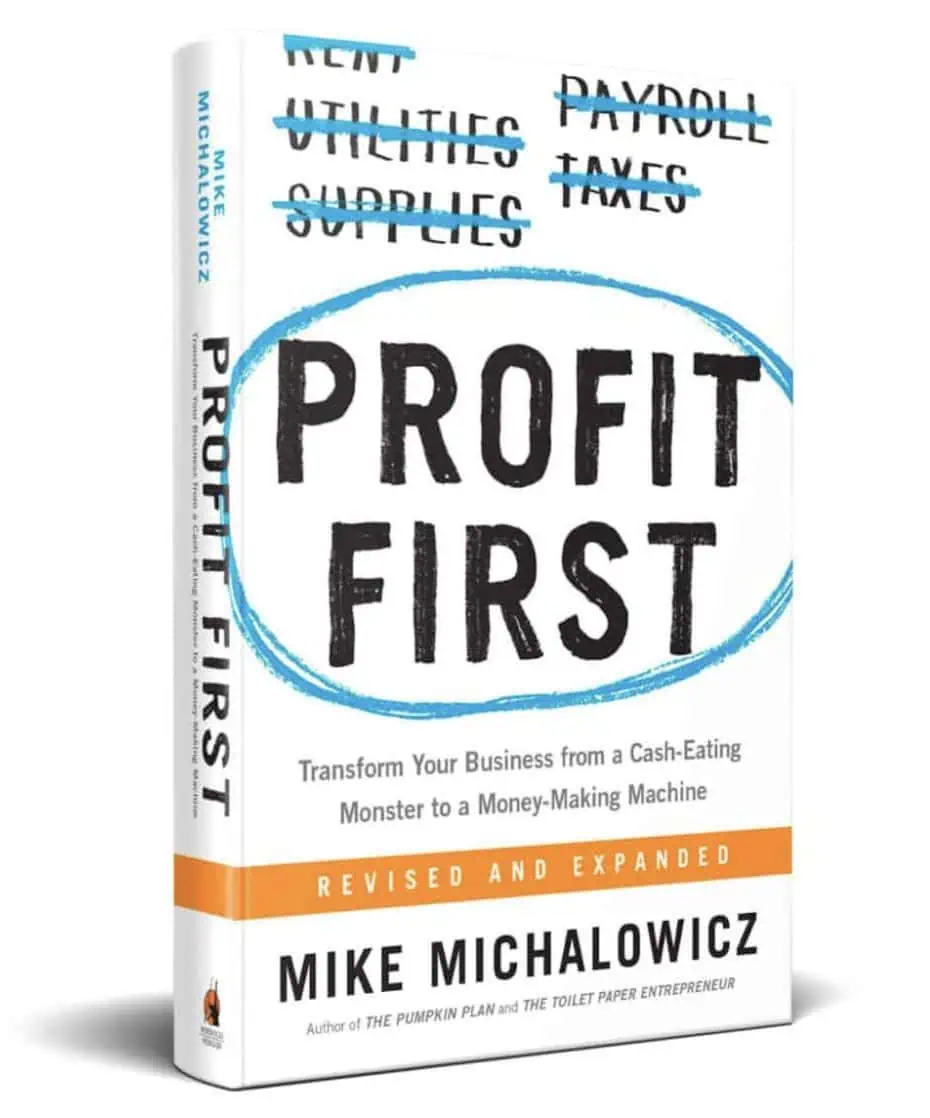
REtipster does not provide tax, investment, or financial advice. Always seek the help of a licensed financial professional before taking action.
 Profit First by Mike Michalowicz radically changed my life.
Profit First by Mike Michalowicz radically changed my life.
I don’t say that lightly.
I read many books, and I can honestly say this is within the top three most impactful books of my life.
I feel like an evangelist—the world needs this book.
It should be required reading for every student graduating high school, let alone every real estate investor.
As an industry, we real estate investors struggle with ego.
We flaunt our gross revenue or deal count, painting a picture that we’re ultra-successful when, behind closed doors, many of us are struggling financially and stressed to the max!
It’s like there's a hole in our pocket—no matter how many deals we do or how much we grow, all the money that comes in goes back out.
Sure, we might be growing, and we might be doubling the deal flow we had a year ago, but are we actually keeping any money once it’s all said and done?
For most of us, if we’re honest… the answer is no. We’re no better off financially than when we first started our real estate business.
This isn’t right.
But there is a solution, and it’s called Profit First.
Revenue – Profit = Expenses
Accountants have been lying to us.
Revenue – Expenses = Profit is dead wrong.
In Profit First, Mike introduces us to the correct formula for profit:
Revenue – Profit = Expenses
Mathematically, these equations are the same, but psychologically they’re complete opposites.
What we prioritize, we place first.
No one goes to the doctor, and upon being told they’re at risk for a heart attack, decides they’re going to put their health last. We would put our health first because there is a new sense of urgency and importance behind getting our health in order.
In the same way, if we place profit as the last priority after revenue and expenses, expenses will ALWAYS eat up our profitability.
When expenses come first, there will always be another reason to spend (or “reinvest”) our revenue.
The cornerstone of Profit First is exactly that: profit must be the priority for any business.
If it’s not, if it’s left last like traditional accounting frames it, it will always be an afterthought.
Profit First and Parkinson’s Law
Profitability boils down to a decision. We choose to be profitable by designating a certain percentage of our gross revenue to profit. Then, we figure out how to run our business on what’s left.
Sometimes, you may limit operating expenses if you take out profit first. Limited resources, however, lead to creativity and ingenuity. When we have no other option, we can accomplish some amazing things with limited resources.
Mike Michalowicz highlights this principle by introducing something called Parkinson’s Law.
Parkinson’s Law is commonly expressed as
“Work expands so as to fill the time available for its completion.”
As supply grows, demand grows to meet it. This means that if we have an abundance of resources, like time, the amount of work given to a certain task will take up the amount of time allocated to accomplishing it.
The opposite is also true.
Even if the time available to perform a task is limited, we can still complete it—and will most likely be accomplished more efficiently due to the limitation.
In the Profit First book, Mike highlights this point by giving an example of a tube of toothpaste.
When it’s a fresh tube, we’re extremely generous with how much toothpaste we use.
When it’s near the end of the tube, however, we’ll squeeze and squeeze and squeeze to get one measly drip, sometimes even cutting the bottom out for maximum efficiency.
If we use this principle to run our business, we’ll soon discover many expenses we can live without.
In Profit First, Growth Is Not the Number One Goal
I spent half my life in the San Francisco Bay Area, the heartbeat of the tech and startup industry.
During my time there, I must have somehow picked up the idea that a business's ultimate goal is growth at all costs.
This is not the case for most businesses.
“Growth at all costs” is something unique to the tech industry. Most tech startups exist to grow to the point that they can get acquired by another company for several million dollars. It’s similar to the objective of developing a house or sub-division, only it’s with a tech company instead of real estate.
I think that due to the popularity and innovation of the tech industry, a lot of other small business owners have fallen into the trap of “growth at all cost.”
Sure, if you’re in tech, this might be your goal leaving profitability on the wayside… but most companies don’t have this objective!
Especially real estate investors, we’re trying to use real estate as a vehicle to grow our wealth and gain more financial freedom.
So, profitability must come first!
The right amount of revenue and deal flow will be a by-product once we prioritize profit.
The Practicals of Profit First
Entrepreneurs are wired in a certain way. We don’t like accounting software and complexity. For us, if we see money in the account, that means we can spend that money on whatever we need or want for the business. If money isn’t there, we hit the panic button and go into grind mode to move more inventory as fast as possible.
Sure, accountants try to tame us into using tools like Quickbooks, telling us, “Never look at the business account!” But what do we end up doing?
Every day, we open our accounts and look.
Profit First is a system built around our natural entrepreneurial behavior. It involves managing our finances through bank accounts. This is essentially the envelope system, modernized by creating several accounts dedicated to specific business functions.
At a basic level, Profit First teaches five foundational checking accounts:
- Income
- Profit
- Owner’s Compensation
- Tax
- Operating Expenses
Two more savings accounts should be held at a different bank.
- Profit Hold
- Tax Hold
Each checking account serves as an “envelope” or “bucket” for different business needs.
Cyclically (the book recommends every 2nd and 25th of the month), predetermined allocation amounts will be distributed to each account based on the current goals and needs of the business.
The income account is where all revenue goes before serving the allocations designated for each account.
Mike recommends target allocation amounts (TAPs) based on a company's revenue in the book.
However, a business might have unique circumstances that hinder its availability to meet TAPs. Therefore, a business decides to allocate current allocation amounts (CAPs). These are usually updated quarterly and, again, are specific to the company's needs and goals.
There is a maxim around Profit First:
When in doubt, open an account!
As a real estate investor, I’ve added a new account to the five essentials: the “OPM” account. I place any private or hard money loans and rent deposits here.
If a business owner needs a new place to store resources for a specific need, they can simply open a new checking account!
It’s just that simple.
The Difference Between Profit and Owner’s Compensation
When you see the five essential accounts above, you might have noticed that there is one for profit and another for owner’s compensation.
It’s important to understand the difference between these two.
Fundamentally, YOU are the most important employee at your company, which means YOU should be compensated for tasks you perform as an employee in the business. This is what the owner’s compensation account is for—making sure you get paid a salary!
Now simultaneously, you’re not only the important employee in your business but you’re also an owner that works on the business.
This is where the profit account comes in.
The owner’s compensation is the money you make for working in your business and profit is the money you earn working on your business.
Typically, the owner’s compensation is paid out regularly (weekly, bi-monthly, or monthly) and profit distribution usually occurs quarterly.
Why Two Savings Accounts at a Different Bank?
Mike Michalowicz is adamant about setting up at least two savings accounts at a separate bank from where you hold the five essential checking accounts.
Again, these two savings accounts are called Profit Hold and Tax Hold.
If we already have a Profit and Tax checking account, why go through the hassle of setting up these savings accounts at a different bank?
Because we’re all human and are subject to temptation.
If we kept all of our profit and tax allocations in a place where we can see it, and that next “once in a lifetime” deal presents itself, we’ll be incredibly tempted to steal from these accounts to make that deal happen.
To avoid this, he strongly suggests having the profit savings and tax savings tucked away where you'll never see them. He even goes as far as to say these two savings accounts shouldn’t even have online banking established. It should be extremely difficult to access these accounts!
This is why we set up a checking and savings accounts for Profit and Taxes. The checking accounts serve as a holding place prior to transfers.
Transferring funds to an outside bank may take a couple of days, and Mike doesn’t want profit or tax allocations to “accidentally” end up in the operating expense account.
Profit First-Friendly Banks
When it comes to the checking and savings account options for Profit First, there are a few requirements:
- There should be no minimum balance fees or monthly service fees.
- The bank must allow for the easy creation of multiple checking/savings accounts and sub-accounts.
- The bank must allow you to nickname the accounts.
- The bank must allow for automation that moves money around automatically.
Relay is a banking platform that partners with Profit First. Mike Michalowicz recommends it for managing your money. They even have a ‘Profit First' set of automations you can implement, and they work well!
These automations make it easy to create new accounts and have automation that puts the money where it needs to be, so you don't even need to think about it!
Alternatively, if Relay doesn't work for you, other banking platforms work similarly and have the same automation functionality built into them.
These banks are all online-only platforms, which means they tend to charge very few (if any) fees for having an account. They also offer more innovative automation, mobile apps, and technology than most brick-and-mortar banks and credit unions, which are stuck in the dark ages.
Final Thoughts
Again, Profit First has radically changed my life.
I now have a framework to understand how to manage money.
Implementing Profit First in my land business taught me that you need two aspects to become a successful real estate investor.
There’s the side of mastering your craft—being the best at finding deals and working your magic as an investor. But there’s also the side of learning how to run a business, specifically how to run the finances of a company.
These are two sides of the same coin.
To be truly successful in real estate, we must learn to master both sides. For me, Profit First was the missing piece.











